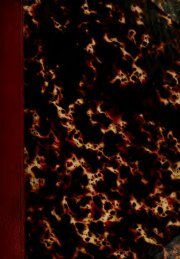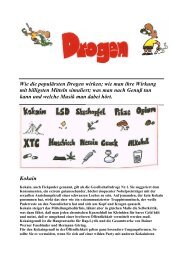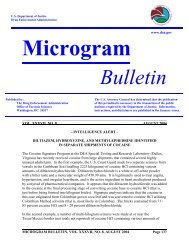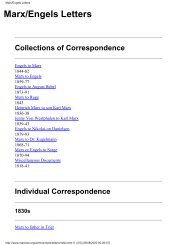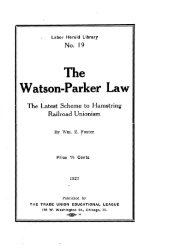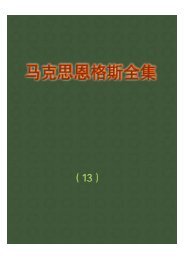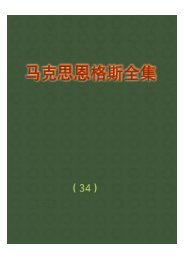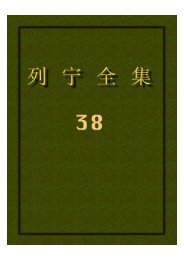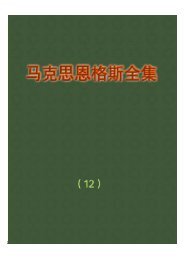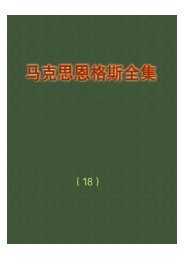MOURA Dinara Jaqueline et al.
MOURA Dinara Jaqueline et al.
MOURA Dinara Jaqueline et al.
Create successful ePaper yourself
Turn your PDF publications into a flip-book with our unique Google optimized e-Paper software.
For antimutagenic ev<strong>al</strong>uation, the procedure was as follows: cells were<br />
submitted to pre-treatment with non-cytotoxic concentrations of <strong>al</strong>k<strong>al</strong>oids and<br />
incubated for 1 h with shaking at 30°C. Cells were then washed and H 2O 2 was<br />
added. The mixture was further incubated at 30°C for 1 h. After treatment,<br />
appropriate dilutions of cells were plated onto SC plates to d<strong>et</strong>ermine cell<br />
surviv<strong>al</strong>, and 100 ll <strong>al</strong>iquots of cell suspension (2 10 8 cells/ml) were plated<br />
onto SC media supplemented with 60 lg/ml canavanine. Plates were incubated<br />
in the dark at 30°C for 3–5 days before counting the survivors and revertant<br />
colonies. All mutagenicity assays were repeated at least three times, and plating<br />
for each dose was conducted in triplicate.<br />
Com<strong>et</strong> assay using V79 cells<br />
Chinese hamster lung fibroblasts (V79 cells) were cultivated under standard<br />
condition in DMEM supplemented with 10% FBS, 2 mM L-glutamine and<br />
antibiotics (49). Cells were maintained in tissue culture flasks at 37°C in<br />
a humidified atmosphere containing 5% CO 2, and were harvested by treatment<br />
with 0.15% trypsin and 0.08% EDTA in PBS. Cells (2 10 5 ) were seeded into<br />
each flask and cultured 1 day prior to treatment. Alk<strong>al</strong>oids were added to FBSfree<br />
medium to achieve the different designed concentrations, and the cells<br />
were treated for 2 h at 37°C in a humidified atmosphere containing 5% CO2.<br />
Oxidative ch<strong>al</strong>lenge with 0.1 mM H2O2 was carried out for 0.5 h in the dark in<br />
FBS-free medium. The culture flasks were protected from direct light during<br />
treatment with the <strong>al</strong>k<strong>al</strong>oids and H 2O 2.<br />
The <strong>al</strong>k<strong>al</strong>ine com<strong>et</strong> assay was performed as described by Singh <strong>et</strong> <strong>al</strong>. (50)<br />
with minor modifications (51). At the end of treatment, cells were washed with<br />
ice-cold PBS and trypsinized with 100 ll trypsin (0.15%). Immediately<br />
thereafter, 20 ll of cell suspension ( 10 6 cells/ml) were dissolved in 0.75%<br />
LMA and spread on norm<strong>al</strong> agarose point (1%) pre-coated microscope slides.<br />
Cells were ice-cold lysed (2.5 M NaCl, 100 mM EDTA and 10 mM Tris, pH<br />
10.0, with freshly added 1% Triton X-100 and 10% DMSO) for at least 1 h at<br />
4°C in order to remove cellular proteins and membranes, leaving the DNA as<br />
‘nucleoids’. Thereafter, slides were placed in a horizont<strong>al</strong> electrophoresis box,<br />
containing freshly prepared <strong>al</strong>k<strong>al</strong>ine buffer (300 mM NaOH and 1 mM EDTA,<br />
pH 13.0) for 20 min at 4°C in order to <strong>al</strong>low DNA unwinding and expression<br />
of <strong>al</strong>k<strong>al</strong>i-labile sites. An electric current of 300 mA and 25 V (0.90 V/cm) was<br />
applied for 20 min to electrophorese DNA. All the steps above were performed<br />
under yellow light or in the dark in order to prevent addition<strong>al</strong> DNA damage.<br />
Slides were then neutr<strong>al</strong>ized (0.4 M Tris, pH 7.5), stained with silver nitrate as<br />
described by Nadin <strong>et</strong> <strong>al</strong>. (52) and an<strong>al</strong>yzed using an optic microscope. Images<br />
of 100 randomly selected cells (50 cells from each of two replicate slides) were<br />
an<strong>al</strong>yzed per group. Cells were <strong>al</strong>so scored visu<strong>al</strong>ly into five classes, according<br />
to tail size (from undamaged, 0, to maxim<strong>al</strong>ly damaged, 4).<br />
Internation<strong>al</strong> guidelines and recommendations for the com<strong>et</strong> assay consider<br />
that visu<strong>al</strong> scoring of com<strong>et</strong>s is a well-v<strong>al</strong>idated ev<strong>al</strong>uation m<strong>et</strong>hod (53). It has<br />
a high correlation with computer-based image an<strong>al</strong>ysis. The damage index (DI)<br />
is based on the length of migration and on the amount of DNA in the tail and is<br />
considered a sensitive measure of DNA and of damage frequency (DF), as the<br />
proportion of cells that show tails after electrophoresis. Image length (IL) or<br />
migration length gives information only about the size of DNA fragments, and<br />
is largely dependent upon electrophoresis conditions (i.e. voltage and duration).<br />
Thus, DI and DF are emphasized in our an<strong>al</strong>yses. The other param<strong>et</strong>er, IL,<br />
though considered in the an<strong>al</strong>ysis, was used only as a complementary DNA<br />
damage param<strong>et</strong>er. DI was thus assigned to each com<strong>et</strong> according to its class,<br />
and ranged from 0 (compl<strong>et</strong>ely undamaged: 100 cells 0) to 400 (with maximum<br />
damage: 100 cells 4) (54). The DF (%) was c<strong>al</strong>culated as the number<br />
of cells with tails versus those without (0–100%). Results are presented<br />
as means and ranges of four independent experiments. The solvent was used as<br />
negative control; MMS (4 10 5 M) and H2O2 (0.1 mM) were used as positive<br />
control.<br />
Hipoxanthine/xanthine oxidase assay<br />
The m<strong>et</strong>hod employed to assay the hydroxyl radic<strong>al</strong>-scavenging ability of<br />
<strong>al</strong>k<strong>al</strong>oids was based on the m<strong>et</strong>hod of Owen <strong>et</strong> <strong>al</strong>. (55). Briefly, <strong>al</strong>k<strong>al</strong>oids were<br />
dissolved in the assay buffer [hypoxanthine, Fe(III), EDTA and s<strong>al</strong>icylic acid]<br />
at a concentration of 2.0 mg/ml and diluted appropriately (in triplicate) in assay<br />
buffer to a fin<strong>al</strong> volume of 1.0 ml giving a range of 0.5–1.5 mg/ml. A 5-ll<br />
<strong>al</strong>iquot of xanthine oxidase dissolved in 3.2 M (NH4)2SO4 was added to initiate<br />
the reaction. The sample tubes were incubated at 37°C for 3 h, at which time<br />
the reaction was compl<strong>et</strong>e. A 30-ll <strong>al</strong>iquot of the reaction mixture was an<strong>al</strong>yzed<br />
by high-pressure liquid chromatography (HPLC) using chromatographic conditions<br />
as previously described (56). Chromatographic an<strong>al</strong>ysis was done using<br />
a gradient based on m<strong>et</strong>hanol–water–ac<strong>et</strong>ic acid with a lBondaPak C18 reverse<br />
phase column (Waters) and d<strong>et</strong>ection at 325 nm. The HPLC equipment had a<br />
2695 separation module (Waters) and UV d<strong>et</strong>ector 2487 (Waters). The hydroxylation<br />
of s<strong>al</strong>icylic acid and hypoxanthine was monitored at A 5 325 and<br />
A 5 278 nm, respectively. The amount of dihydroxyphenol, 2,5-dihydrox-<br />
Antioxidant properties of b-carboline <strong>al</strong>k<strong>al</strong>oids<br />
ybenzoic acid and 2,3-dihydroxybenzoic acid (DHBAs), produced by the<br />
reaction of s<strong>al</strong>icylic acid with produced hydroxyl radic<strong>al</strong>s (OH_) was d<strong>et</strong>ermined<br />
from standard curves of the respective dihydroxyphenols.<br />
Statistics<br />
Statistic<strong>al</strong> an<strong>al</strong>yses of the data were performed using one-way an<strong>al</strong>ysis of<br />
variance (ANOVA)–Tukey’s multiple comparison test. P-v<strong>al</strong>ues under 0.05<br />
were considered significant. Data were expressed as means SDs v<strong>al</strong>ues.<br />
Results<br />
Protective effects of b-carbonilic <strong>al</strong>k<strong>al</strong>oids in S. cerevisiae<br />
strains<br />
WT cells and isogenic mutant strains of S. cerevisiae lacking<br />
antioxidant defenses (Table I) were treated with sever<strong>al</strong> concentrations<br />
of the <strong>al</strong>k<strong>al</strong>oids for 1 h during the stationary phase.<br />
All strains showed practic<strong>al</strong>ly the same sensitivity for bcarbolines<br />
to that observed for the WT cells (Figure 2). Our<br />
findings showed that harmane, harmine and harmol decrease<br />
viability but, in a significant way, only in concentrations up to<br />
150 lg/ml, whereas harm<strong>al</strong>ine and harm<strong>al</strong>ol do not induce<br />
significant effects in any of the concentrations employed.<br />
In this manner, we chose non-cytotoxic <strong>al</strong>k<strong>al</strong>oid concentrations<br />
(ranging from 25 to 100 lg/ml) to follow experiments in<br />
order to verify the protecting activity against oxidants in the<br />
same strains.<br />
To verify an intracellular protective effect of the <strong>al</strong>k<strong>al</strong>oids,<br />
i.e. a possible role of b-carboline <strong>al</strong>k<strong>al</strong>oids in cell oxidative<br />
stress, yeast cells were pre-treated with non-cytotoxic concentration<br />
of harmane, harmine, harmol, harm<strong>al</strong>ine or harm<strong>al</strong>ol,<br />
and then further exposed to sub-l<strong>et</strong>h<strong>al</strong> concentrations of either<br />
H2O2 or paraquat. A statistic<strong>al</strong>ly significant surviv<strong>al</strong> was observed<br />
as a consequence of antioxidant effect of the <strong>al</strong>k<strong>al</strong>oids.<br />
The aromatic b-carboline harmane significantly enhanced<br />
the surviv<strong>al</strong> of <strong>al</strong>l yeast cells, with EG103 background at 50<br />
and 100 lg/ml after treatment with H2O2 (Figure 3A), showing<br />
a clear antioxidant protective effect. However, after treatment<br />
with paraquat, this effect was less significant, being more<br />
effective at 50 lg/ml in these strains (Figure 4A). Although<br />
harmane did not protect YPH98 WT against any of the two<br />
oxidative agents, an important antioxidant effect was observed<br />
against H2O2 for yap1D, as verified by the increase in surviv<strong>al</strong><br />
after oxidative ch<strong>al</strong>lenge and shown in Figure 3A.<br />
Figure 3B shows that harmine at 50 lg/ml was able to<br />
protect sod1D, sod2D and ctt1D single mutants against H2O2<br />
cytotoxicity. In addition, this activity was more effective in the<br />
sod1Dctt1D double mutant. However, this <strong>al</strong>k<strong>al</strong>oid did not<br />
protect any yeast strain against the del<strong>et</strong>erious effects of paraquat<br />
(Figure 4B).<br />
After treatment with H2O2, the harmol antioxidant activity<br />
was only observed for the strains deficient in both superoxide<br />
dismutases (SODs) (single and double mutants) and in the<br />
transcription factor-deficient mutant yap1 (Figure 3C). However,<br />
harmol protected EG103 WT as well as sod1D, ctt1D<br />
single and sod1Dsod2D, sod1Dctt1D double mutants against<br />
treatment with paraquat (Figure 4C).<br />
Harm<strong>al</strong>ine (Figures 3D and 4D) showed a significant protection<br />
against H2O2 and paraquat, respectively, <strong>al</strong>though this<br />
effect is more prominent in the single sod-deficient mutants.<br />
Dihydro-b-carboline harm<strong>al</strong>ol demonstrated the strongest<br />
antioxidant effect (Figures 3E and 4E). This <strong>al</strong>k<strong>al</strong>oid significantly<br />
enhanced the surviv<strong>al</strong> of yeast cells at 50 and 100 lg/ml<br />
for EG103 WT and its sod isogenic mutant strains (sod1D,<br />
sod2D and sod1Dsod2D) in the pre-treatment assay, using<br />
295<br />
Downloaded from<br />
mutage.oxfordjourn<strong>al</strong>s.org by guest on May 16, 2011



